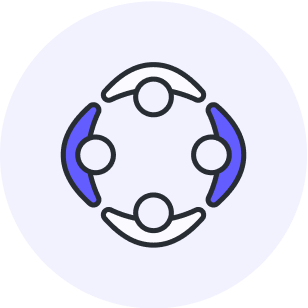
The evolution of collaboration: Looking back to move forward
Reading time: about 7 min
Topics:
By definition, evolution is the process of change in a certain direction. It is adapting to a changing environment to not only survive but to succeed. Throughout history, plants and animals have had to adapt to environmental changes like new weather patterns and predators. While businesses don’t necessarily have predators, they do have competition and have had to adapt to changes in technology and market conditions.
Whether organizations upgrade their outdated technology or completely restructure their work model due to a global pandemic, companies must evolve their collaboration strategies to stay afloat and remain competitive.
We sat down with Nathan Rawlins, Lucid’s chief marketing officer, to discuss how workplace collaboration has dramatically changed in the last several decades and how important it is for businesses to adapt to their current conditions.
Understanding and recognizing our origins can propel us into a new age of better, more effective collaboration.
“Companies and teams won’t succeed unless they are deliberate about changing and improving their practices. There is so much unrealized potential that will only be realized when leaders become deliberate about change.”
—Nathan Rawlins, chief marketing officer at Lucid
Digital collaboration timeline
Before we can move forward, we must first understand where we came from and why improving collaboration is vital.

1980s
So much came from the 1980s: leather jackets, Taylor Swift, and, best of all, the workplace PC (personal computer). Integrating the PC into the workplace meant that companies could digitize many of the physical formalities of working. Prior to the PC, transparencies were the closest thing used to share visual information with an audience.
When Microsoft PowerPoint came along, it was essentially the same idea as transparencies, only on a PC. Professionals could present to colleagues and customers in a more convenient way, but it was very one-sided. If colleagues had feedback to share, they either had to stop mid-presentation or wait until the end to share their thoughts.
These were the very early stages of digitization. Personal computers were new, and companies and computer engineers were merely exploring how they worked and what was possible.
“In the 80s, we basically just took the physical ways of working and digitized them,” said Rawlins
Projects were less about collaboration and more about handoffs. There were more hierarchies in communication than we have today. While technology was emerging, the workplace still lacked true collaboration platforms and tools.
1990s
The World Wide Web surfaced in 1991, enabling people to connect documents that could be accessed worldwide. Throughout the 90s, more and more companies began building web-based software, but it was nothing like the software we see today. It was strictly transactional.
We also saw the rise of email, which was transformative in terms of communication. No longer did we have to communicate only within the walls of the office. While email didn’t solve the need for workplace collaboration, it was a good starting point for more effective communication.
Rawlins shares that much of this software was primarily focused on shuttling documents around. While this made working easier, it still lacked in the areas of connection and collaboration simply because the technology wasn't advanced enough for real-time communication.
2000s
Mobile and cloud technologies began to evolve based on the transactional software we saw emerge in the 1990s. As laptops and mobile phones were woven into the workplace, the need for better, more accessible communication tools was recognized. The app economy boomed and set higher expectations for what software should look like.
Teams started working in more dispersed locations, and social media platforms introduced the possibility of connecting from anywhere. The Agile Manifesto was born in 2001, introducing a more collaborative way of working which started to shift how we think about workplace collaboration.
In addition, companies started modernizing instant messaging and online chatting. This wasn't a new concept, as it emerged from (the now long-ago) Internet relay chat (IRC), but platforms like Slack eventually took this idea and ran with it. They streamlined communication and eventually made it an indispensable tool for many teams today. Even so, these tools were primarily focused on communication rather than collaboration.
“Meetings were still followed by creating documentation and emailing it around to people, creating a giant email thread,” said Nathan. “The text-heavy nature of this way of working made it challenging to solve problems and make decisions as a group.”
2010s
In the 2010s, more effective workplace collaboration tools started appearing. We previously had Visio, which had once been an innovative product for diagramming, but it lacked (and still lacks) real-time collaboration capabilities.
That’s when Lucidchart was born, in 2010, pioneering the world of the infinite canvas. It was built with the intention of shifting away from point-in-time interactions and making collaboration a fluid (lucid, if you will) experience.
This era saw more products and tools, like Google Docs and Zoom, that evolved to meet the needs of the shifting workplace and make real-time collaboration possible, from anywhere.
The present
So, where are we now? The COVID-19 pandemic launched us into a hyper-shift of our working norms. Tools that got us by before were no longer going to cut it when half of your team’s bedroom closets were suddenly transformed into their corporate office. Gathering in a physical meeting room became impossible, so how could we intentionally project plan, ideate, and create?
Shifting to fully remote forced us to recognize the gap in technology. Teams needed a way to enable and enhance human connection in a virtual setting. We quickly learned that our old in-office practices needed a makeover.
We now understand that every team is a hybrid team. No matter where you work, there will always be team members who miss context from being out sick, on vacation, or for other reasons. As more companies implement return-to-office policies, we must be careful not to lose what we learned. Teams need more natural and quicker ways to communicate with each other, balancing synchronous and asynchronous work without losing important context to do their jobs well.

Explore the lessons learned from remote work that carry over into hybrid and in-person teams.
Go nowTeams can now work side by side, regardless of their location, while having access to the resources they need. The spread of AI and automation continues to transform our workflows, making collaboration more efficient and inclusive and enabling us to take a more egalitarian approach to leadership. Leaders value gathering input from their teams. We see industries shifting to put digital collaboration first, and are recognizing these benefits.
One example of this is seen in agile teams. Though Agile methodologies have been around for decades, the technologies to support these teams haven’t. Companies like Lucid focus on meeting the needs of agile teams, specifically hybrid teams, so they can collaborate with context, clarity, and alignment. Rawlins explained:
“The way that we have worked together as teams has changed. It’s less hierarchical, more fluid, and more iterative. At the same time, we have been changing our technology to enable better collaboration.”
What organizations need to thrive in the modern workplace
As you can see, we have come a long way in terms of how we work. It is by no means perfect, but we are starting to grasp what it truly means to collaborate with our teammates and that meaningful connections don’t always need to happen in the same room. We have also recognized the vital role that visuals play in collaboration. Visuals help us communicate, ideate, and plan far better than verbal or written communication.
What challenges are left to tackle? Rawlins shares that many organizations still aren’t taking the steps needed to fully adapt. Change takes time and is difficult. In fact, we conducted a survey that revealed only 43% of organizations have implemented digital collaboration tools. That leaves a lot of room for improvement. Companies need to be deliberate about change; otherwise, they won't change.
Moving forward, it will be important to recognize that all teams are hybrid teams and all companies need digital-first collaboration. The sooner we realize this, the sooner we can adopt more effective tools and practices that boost visual collaboration, creativity, and alignment.

Digital-first collaboration guide
Learn what tools and techniques orgs need to adapt to today’s working environment.
Read nowAbout Lucid
Lucid Software is the leader in visual collaboration and work acceleration, helping teams see and build the future by turning ideas into reality. Its products include the Lucid Visual Collaboration Suite (Lucidchart and Lucidspark) and airfocus. The Lucid Visual Collaboration Suite, combined with powerful accelerators for business agility, cloud, and process transformation, empowers organizations to streamline work, foster alignment, and drive business transformation at scale. airfocus, an AI-powered product management and roadmapping platform, extends these capabilities by helping teams prioritize work, define product strategy, and align execution with business goals. The most used work acceleration platform by the Fortune 500, Lucid's solutions are trusted by more than 100 million users across enterprises worldwide, including Google, GE, and NBC Universal. Lucid partners with leaders such as Google, Atlassian, and Microsoft, and has received numerous awards for its products, growth, and workplace culture.
Related articles
Lessons learned from remote work that you should bring back to the office
Here are six lessons we’ve learned from remote work that you should bring with you to the office.
The problems with workplace collaboration today—and how to fix them
Uncover the top collaboration problems that organizations can't ignore any longer in this blog by Nathan Rawlins, Lucid CMO.
[Guide] How to set up your hybrid workplace to maximize collaboration
Every team is a hybrid team. Learn how to set up your hybrid workplace with the right office design and culture to maximize collaboration.
6 organizational collaboration lessons to boost efficiency and engagement
Read first-hand stories about organizational collaboration, and use the takeaways to improve collaboration in your organization.